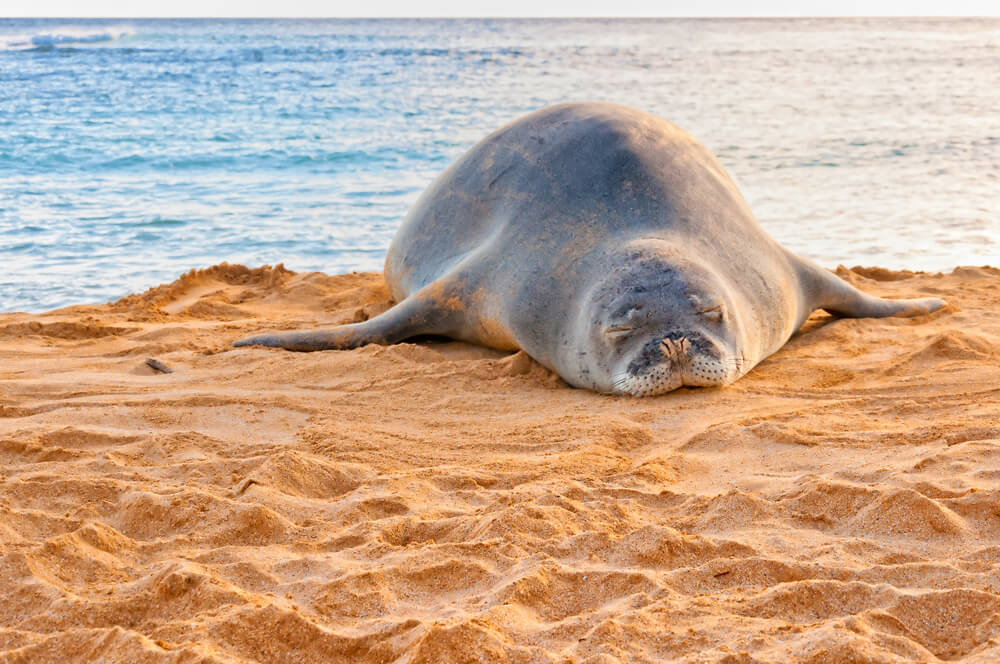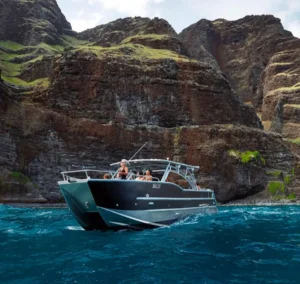Hawaiian monk seals are one of the only two surviving species of monk seals found on earth today. In ancient Hawaiian, these seals were called “Ilio holo I ka uaua” meaning “dog that runs in rough water.” Monk seals might’ve got their name for the multiple folds of skin behind their neck that appears like a monk’s hood, or for their seclusive nature.
According to NOAA Fisheries, the Hawaiian monk seal population is estimated to be around 1400 seals- about 1,100 seals on the Northwestern Hawaiian Islands (NWHI) and 300 seals in the Main Hawaiian Islands (MHI).
Their numbers had been consistently decreasing for over six decades for a variety of reasons – some of which are marine debris, shark predation, hunting and lack of nourishment. Contrarily, the last few years have reported growing figures, mainly because of the initiatives taken by different volunteering bodies towards their protection and preservation.
What Do They Feed On?
The Hawaiian monk seals eat a variety of marine species like reef fish, squid, octopus, eels and crustaceans like crab, lobster and shrimp. They normally hunt for prey that are easy to catch.
These creatures are known to be “opportunistic feeders.” It is this quality that makes monk seals notorious among fishermen. Although monk seals don’t hunt in the areas where fishermen have cast their nets, in some occurrences, seals have either preyed on the catch made by these fishermen and even fed on the bait caught in the hook. This means that they are smart enough to let the fishermen do all the work before they snatch the prey. Smart animals!
Birthing Season
Hawaiian monk seals rest, molt and give birth on land, where they spend most of their time. The mother seal nurses her young one for a period of six weeks. During this period, her body uses up the blubber to produce milk to feed the babies. Following this one and a half month period, her body is exhausted and she leaves her young ones to fend for themselves.
The baby seals weigh only 25 to 35 pounds, but, put on a massive amount of weight during the nursing period. Adult seals can be as heavy as 600 pounds, which makes them even more cute as they hump through the sand with their front flippers.
These seals eat 6 to 8% of their body weight per day and all the excess energy gets stored as fat, which is put to use during nursing and molting.
Where to Find Them?
These sea lions live in warm tropical waters and spend two thirds of their lifetime at sea. Hawaiian monk seals are commonly found in areas like atolls, beaches with shallow waters and protected sandy shores, and on volcanic rocks, as these conditions are ideal for resting and pupping.
The most likely place to spot monk seals in the Hawaiian islands is on Kauai- because it is very close to their primary feeding grounds. In Kauai, Poipu beach is a popular spot for monk seal sighting as they’re often seen sunbathing here. Another spot to find them would be along the remote beaches of the Napali coast, where they enjoy their private time.
Although May is the peak birthing season for Hawaiian Monk seals, your chances of spotting one may be slim. Unlike the whale watching season, there is no monk seal watching season in Kauai. So, consider yourself very lucky if you spot one and when you do, make sure you follow the guidelines outlined below.
Safety Tips for Seal Watching
Coming across a monk seal on a beach in Kauai can be an exciting experience. But it’s in your best interests to you contain the excitement and follow certain rules or guidelines that have been laid down by the Kauai authorities for the protection of these endangered mammals.
You will come across warning signages on the white sandy of beaches that are known for monk seal sightings. ‘Do not disturb’, ‘Please do not approach’ are some of the common signs you’ll see and ones which shouldn’t be too hard to follow. These beaches also have sign posts with visual elements that convey a similar message.
The Hawaiian monk seals are native to the Hawaiian islands and are seldom found anywhere else. Thus, these mammals have a very special place in the hearts of the island folks. Hawaiian monk seals are listed among endangered species of the world and are protected by the endangered species act and the marine mammals protection act.
Following the safety guidelines will not only help the seals get their privacy, but, will also save you from the heavy fines that will be imposed if you’re found breaking these rules. The ceiling on these fines can be as high as $25000 and may even lead to imprisonment. There have been some instances where certain adventurous people have been fined heavily for crossing their lines.
Here are some of the safety tips you should adhere to and help protect the hawaiian monk seals:
Do not disturb the seal, especially when it is nursing its young one. This distraction may cause the seal to stop its natural process of nursing and feeding or even run away, causing the its baby to be abandoned. Also, when threatened, they may cause injury to humans.
There usually are protective barricades surrounding the area where the monk seals rest. But in case there aren’t any, maintain a safe distance (at least 150 feet) from them and do not attempt to touch, chase or feed the seals. This holds good for all the marine species you come across on the island.
If you’re with a pet, make sure it is kept on a leash at all times when you’re on the beach.
Seals are normally found swimming in the shallow waters before coming on shore. If you encounter a seal while swimming, its advisable to keep a safe distance and cautiously get out of the water to avoid any trouble.

Conclusion
Poipu beach has been noticing increasing number of monk seal visits in recent years. For this reason, more people are flocking to the beach to have a glimpse of the marvelous creatures resting and sunbathing on the shore. Though the seals worship their privacy, they don’t seem to be offended by the attention they’re getting.
So what will you do when you spot a monk seal on your next Kauai visit?




Comments
Put up a stick barrier at least 150 ft. Around the seal and call the number for the people to come put up the signs. I have encountered one young pup and people were petting it! We put up as wide a stick barrier as we could, but we had no numbers to call.
We spotted a monk seal during our visit to Pouipu beach in Kauai. The volunteers put barrier around it. It stayed for half hour on the beach and went back to water. Definitely not as a unique experience to have spotted it.
We spotted a monk seal during our visit to Pouipu beach in Kauai. The volunteers put barrier around it. It stayed for half hour on the beach and went back to water. Definitely a rare and unique experience to have spotted it.
Pingback: 20 Unique Mammals Found Nowhere Else but the USA - Exploring Animals